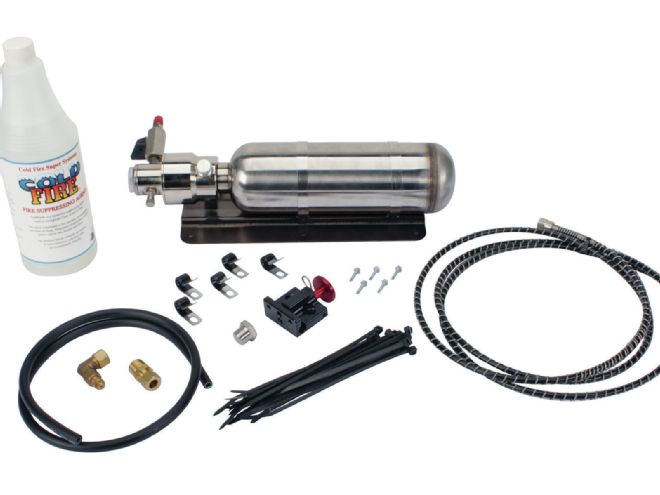
Looking at the photos of Tom Medley’s fire-ravaged ’40 (see page 122) were personally thought provoking for a number of reasons. First and foremost was a feeling of relief that my good friend escaped injury from the blaze that reduced his garage to charred rubble, second was sadness at the apparent loss of a great car Tom worked so hard to build and one I’ve had the opportunity to drive many miles, and lastly was the sobering realization that disaster can strike anyone at any time.
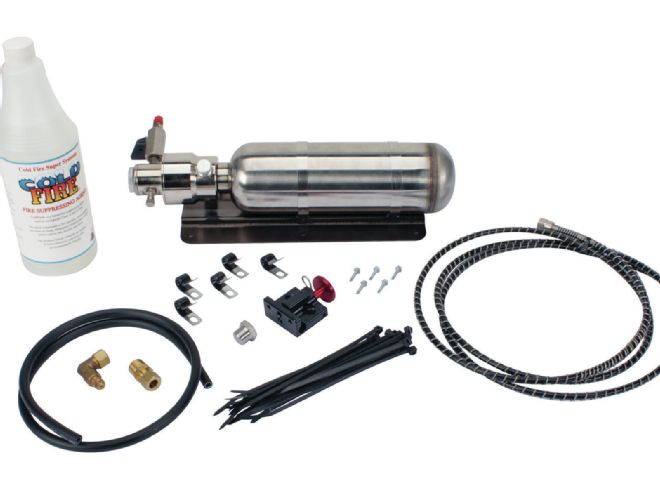 As shown here, the Speedway Motors Cold Fire System comes complete, ready to install. Compact and unobtrusive, no one will know it’s there—until it’s needed. A straight nozzle is included; the 360-degree pattern is designed to be installed to shower the area in harms way. The nozzles are nickel-plated brass with 1/8-inch NPT male pipe threads.
As shown here, the Speedway Motors Cold Fire System comes complete, ready to install. Compact and unobtrusive, no one will know it’s there—until it’s needed. A straight nozzle is included; the 360-degree pattern is designed to be installed to shower the area in harms way. The nozzles are nickel-plated brass with 1/8-inch NPT male pipe threads.
It goes without saying that equipping your street rod with a fire extinguisher is a good idea. However, if it’s not in a handy location by the time you dig it out of the trunk or some other hard to access location, it may be too late. And then there’s the problem of a fire starting when no one is around, or even worse, if the driver is incapacitated for some reason. All these issues are addressed by a new fire suppression system available from Speedway Motors called Cold Fire.
As the manufacturer of the Cold Fire suppressant explains it, fires have three components to deal with: heat, fuel, and oxygen. The extinguishing agent used in the Speedway system breaks down and removes heat and fuel from the fire without affecting the available oxygen, which allows personnel to see and breathe and safely leave the area.
The Cold Fire extinguishing agent is made from water and plant extracts that give it six times the penetrating capability of water alone, along with a remarkable capability to absorb heat. This means the Cold Fire suppressant will get to the source of the fire faster, absorb heat, and bring the fuel source under its flashpoint quickly. It is a UL listed wetting agent for class A (wood and paper) and class B (fuel and oil) fires and also works on Class D (metal) fires.
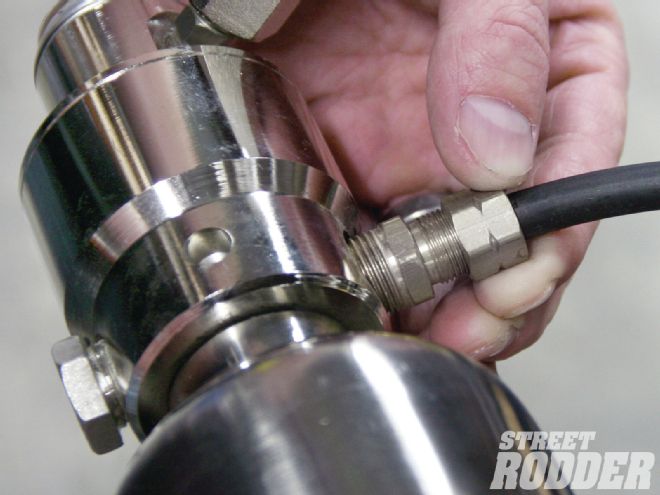 Automatic discharge of the Cold Fire suppressant is through a line connected to the valve on the cylinder. It is triggered when the detector line is ruptured or the manual valve is pressed.
Automatic discharge of the Cold Fire suppressant is through a line connected to the valve on the cylinder. It is triggered when the detector line is ruptured or the manual valve is pressed.
As supplied by Speedway, the system consists of a stainless steel cylinder with a mount to contain the Cold Fire agent, a length of composite line and a nozzle for automatic discharge, manual control and automatic valves, a length of unique “detection tubing” fittings to make all the necessary connections, installation hardware, and complete instructions.
When installing Speedway’s Cold Fire system, the cylinder should be located as close as possible to the area being protected and be mounted in the horizontal position with the cylinder valve facing the rear of the vehicle and oriented so that the pressure gauge is visible. The manual button should be placed within easy reach of the driver, and then it’s a matter of routing the detector line and a second discharge line with one or two nozzles.
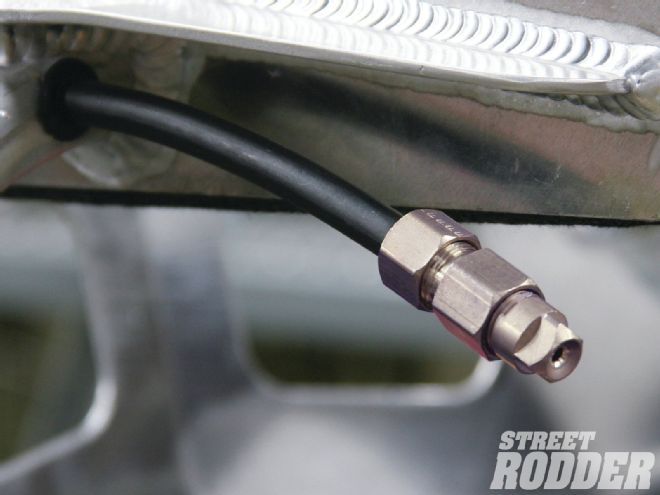 One or more nozzles can be installed on the automatic discharge line. They can be positioned anywhere fire protection is necessary, under the hood, behind the dashboard, inside the passenger compartment, or in the trunk if that’s where the gas tank is.
One or more nozzles can be installed on the automatic discharge line. They can be positioned anywhere fire protection is necessary, under the hood, behind the dashboard, inside the passenger compartment, or in the trunk if that’s where the gas tank is.
After installation, the tubing is pressurized with nitrogen to 175 psig—that pressure keeps the valve on the cylinder in the closed position. If a fire starts in the engine compartment the heat-sensitive tubing will rupture at any point where the temperature reaches 176 degrees F. That opening in the tubing does two things, it releases the nitrogen pressure in the line, which causes the valve on the cylinder to open and the Cold Fire suppressant to be released through the nozzle (or nozzles) in the automatic line. The opening created in the detector line also acts as a nozzle and directs the Cold Fire material at the source of heat that caused the rupture.
The manual activator is installed in the detector line, pushing its button pierces the line—again the pressure in the line is released, the valve on the tank opens and retardant is dispensed at the button and from the nozzle (or nozzles) in the automatic line.
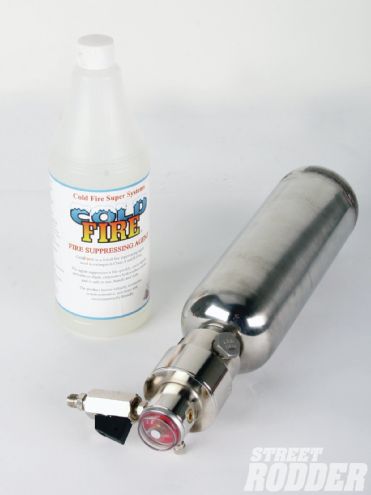 Cold Fire’s suppressant is clean, leaving little or no residue after discharge and it is also environmentally friendly, having an ozone depletion potential (ODP) of 0.00.
Cold Fire’s suppressant is clean, leaving little or no residue after discharge and it is also environmentally friendly, having an ozone depletion potential (ODP) of 0.00.
Speedway Motors’ Cold Fire system is unique in that it can be discharged manually or triggered by a fire. The system is easy to install, simple to maintain, and can be used and recharged. At the $499 list price, it may be the investment you can make, and it’s certainly a good buy for a full-time fire fighter.